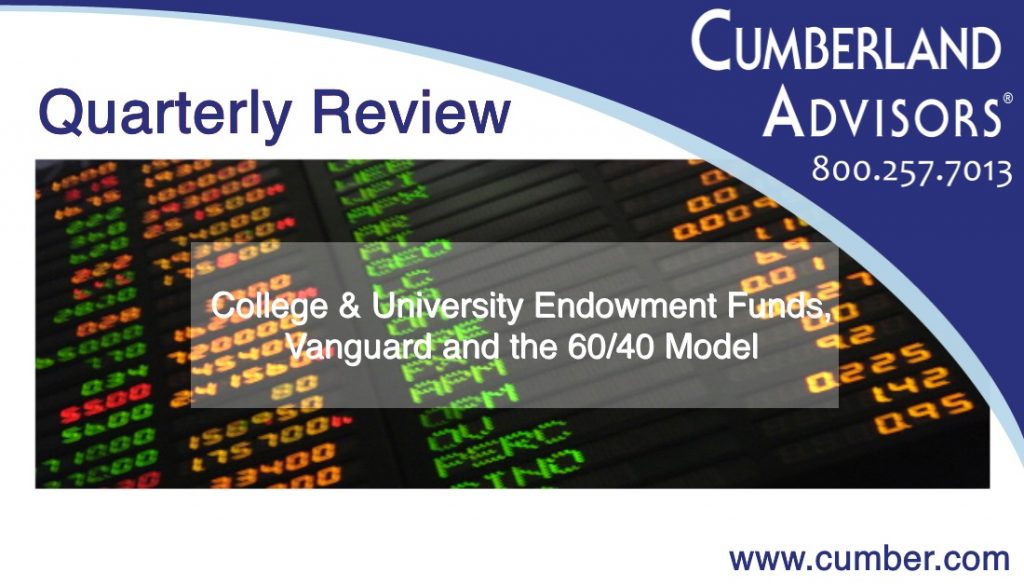At the conclusion of each fiscal year, Commonfund and the National Association of College and University Business Officers (NACUBO) team up and publish a study analyzing the return and asset-allocation metrics across the country’s higher education endowment funds.

They refer to this annual analysis as the NACUBO-Commonfund Study of Endowments® (NCSE).[1] For FY2017 (July 1, 2016 – June 31, 2017), 809 colleges and universities participated. Institutions are organized by asset size and are placed into one of six categories (>$1 billion, $501 million–$1 billion, $101 million–$500 million, $51–$100 million, $25–$50 million, <$25 million). The largest number of endowments falls within the $101–$500 million range, with 275 funds represented. Below are the highlights:
- “Average FY2017 returns were positive for institutions in all six categories, reversing last year’s results, when returns were negative for all six. From high to low this year, the spread of returns across the size cohorts was a tight 130 basis points (1.3 percentage points).” The average FY2017 return for endowments over $1 billion was 12.2% while funds under $25 million returned an average of 11.6%. For funds in the $101–$500 million range, the average net return was 12.5%.
- “When asset allocation is viewed by size of institutions, larger endowments continue to significantly overweight alternative strategies, while smaller endowments have larger allocations to traditional asset classes, such as U.S. equities and fixed income.” Endowments with over $1 billion had a 32% slice in traditional global equities and 57% in alternative investments (hedge funds, private equity, venture capital, real assets, etc.). In stark contrast, endowments under $25 million placed 58% in global equities and 11% in alternatives.
- “Compared with the Study universe return of 12.2 percent,” across all 809 institutions, “the top decile reported an average return (net of fees) of 15.8 percent, and the top quartile reported an average net return of 14.8 percent…. Top decile performers (largely reflecting higher allocations to the best performing asset classes, non-U.S. equities and U.S. equities) reported an allocation to alternative strategies averaging just 39 percent compared to 52 percent for the Study universe. Last year, the allocation to alternatives among the top decile was 62 percent.” In essence, alternative strategies resulted in a drag on performance.
- According to Francis M. Kinniry, a principal in Vanguard Investment Strategy Group, “Institutions in the ‘$101 Million to $500 Million’ NACUBO cohort reported an average fee of 1.54%.” This average fee excludes performance fees.[2]
Kinniry compared the returns generated by a globally diversified bond and stock portfolio within the classic 60% stock/40% bond construction against the returns generated by the NACUBO-Commonfund study. Kinniry’s global portfolio was designed and measured using indices, so no fees were associated with the theoretical portfolio. The 10-year average rate of return for this model portfolio of indices was 5.6%. The NACUBO-Commonfund endowment portfolios returned between 5.0% and 4.6%.
We can compare these returns to Vanguard’s Balanced Index Fund (VBINX), which comprises 60% domestic equity and 40% domestic investment-grade fixed income. This fund has a lengthy track record dating back to 1992. A link to Vanguard’s 2017 semi-annual report can be found in the third citation below[3]. On page 8 of the report, 1-year, 5-year, and 10-year average returns are reported. We encourage our readers to glance at these returns and compare them to the figures found in the NACUBO-Commonfund report. When working with nonprofits, small and large, to select an appropriate long-term investment strategy for perpetual funds, Cumberland continues to be a proponent of the classic 60/40 approach. For individuals and organizations seeking a long-term buy-hold-rebalance approach, Cumberland Advisors manages a strategy, dubbed Active Taxable or Tax-Free Bonds/Passive Equity that joins passive equity exposure (60%) with active bond management (40%).[4]
Gabriel Hament
Foundations and Charitable Accounts
Email | Bio
[1] https://www.commonfund.org/news-research/press-release/2017-ncse-survey-results-released/
[2] https://www.advisorperspectives.com/articles/2018/06/04/can-you-replicate-the-results-of-top-endowments?EXCMPGN=EX:PC:FAS:Sustaining
[3] http://www.vanguard.com/us/litfulfillment/ELFReports?categoryCd=PRRP&subcategoryCd=MFRP&view=default
[4] http://www.cumber.com/spiva-and-active-bond-management/
Links to other websites or electronic media controlled or offered by Third-Parties (non-affiliates of Cumberland Advisors) are provided only as a reference and courtesy to our users. Cumberland Advisors has no control over such websites, does not recommend or endorse any opinions, ideas, products, information, or content of such sites, and makes no warranties as to the accuracy, completeness, reliability or suitability of their content. Cumberland Advisors hereby disclaims liability for any information, materials, products or services posted or offered at any of the Third-Party websites. The Third-Party may have a privacy and/or security policy different from that of Cumberland Advisors. Therefore, please refer to the specific privacy and security policies of the Third-Party when accessing their websites.
Sign up for our FREE Cumberland Market Commentaries
Cumberland Advisors Market Commentaries offer insights and analysis on upcoming, important economic issues that potentially impact global financial markets. Our team shares their thinking on global economic developments, market news and other factors that often influence investment opportunities and strategies.

